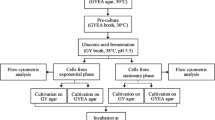Summary
In methanol-utilizing yeasts, catalase is an essential enzyme for the destruction of hydrogen peroxide generated by methanol oxidase (E.C. 1.1.3.13). It was found however that a catalase-negative mutant of Hansenula polymorpha is able to consume methanol in the presence of glucose in continuous cultures. At a dilution rate of 0.1 h-1, stable continuous cultures could be obtained during growth on methanol/glucose mixtures with a molar ratio of methanol/glucose between 0 to 2.4. In these cultures methanol oxidase was induced up to a level of 40% of that obtained in the wild-type strain. The hydrogen peroxide-decomposition activity of the mutant was studied in more detail by pulsing methanol to samples of steady-state cultures. Only after the addition of excess methanol the hydrogen peroxide-decomposing system became saturated, and the cells excreted hydrogen peroxide. This was accompanied by excretion of formaldehyde and a rapid loss of viability. The presence of extracellular catalase during a methanol pulse prevented the loss of viability. The nature of the alternative hydrogen peroxide-decomposing enzyme system remains to be elucidated. Its capacity strongly depended on the cultivation conditions and pretreatment of the cells. Cells grown on formaldehyde/glucose mixtures showed a lower methanol tolerance than those grown on the methanol/glucose mixtures. Freeze-drying of cells drastically enhanced the excretion of hydrogen peroxide, probably as a result of an inactivation of the decomposing system.
Similar content being viewed by others
References
Aisaka K, Uwajima T, Terado O (1982) Glutathione peroxidase from Mucor hiemalis. Agric Biol Chem 46:3113–3114
Dijken van JP, Otto R, Harder W (1976) Growth of Hansenula polymorpha in a methanol-limited chemostat. Physiological responses due to the involvement of methanol oxidase as a key enzyme in methanol metabolism. Arch Microbiol 111:137–144
Eggeling L, Sahm H (1980) Regulation of alcoholoxidase Synthesis in Hansenula polymorpha: oversynthesis during growth on mixed substrates and induction by methanol. Arch Microbiol 127:119–124
Egli Th (1980) Wachstum von Methanol assimilierenden Hefen. Thesis ETH no. 6538, Zürich
Egli Th, Käppeli O, Fiechter A (1982) Mixed substrate growth of methylotrophic yeasts in a chemostat culture: influence of the dilution rate on the utilisation of a mixture of glucose and methanol. Arch Microbiol 131:8–13
Geissler J, Ghisla S, Kroneck MH (1986) Flavin-dependentalcohol oxidase from yeast. Studies on the catalytic mechanism and inactivation during turnover. Eur J Biochem 160:93–100
Giuseppin MLF, van Eijk HMJ, Bante I, Verduyn C, Van Dijken JP (1988) Production of catalase-free alcohol oxidase (MOX) by Hansenula polymorpha. Appl Microbiol Biotechnol 28:14–19
Lang E, Lang H (1972) Spezifische Farbereaction zum direkten Nachweis der Ameisensäure. Z Anal Chem 260:8–10
Lowry OH, Rosebrough NJ, Farr AL, Randall RJ (1951) Protein measurements with the Folin phenol reagent. J Biol Chem 193:265–271
Nash T (1953) The colorimetric estimation of formaldehyde by means of the Hantzsch reaction. Biochem J 55:416–421
Paglia DE, Valentine WN (1967) Studies on the quantitative and qualitative characterization of erythrocyte glutathione peroxidase. J Lab Clin Med 70:158–169
Smith J, Schrift A (1979) Phylogenetic distribution of glutathione peroxidase. Comput Biochem Physiol 636:39–44
Tani Y, Sakai Y, Yamada H (1985) Isolation and characterization of a mutant of a methanol yeast. Candida biodinii, with higher formaldehyde productivity. Agric Biol Chem 49:2699–2706
Unilever patent 1984 EPA 0173378
Unilever patent 1986 NL 8602978
Veenhuis M, Dijken van JP, Harder W (1980) Cytochemical studies on the localisation of methanol oxidase and other oxidases in peroxisomes of methanol-grown Hansenula polymorpha. Arch Microbiol 111:123–135
Verduyn C, Dijken van JP, Scheffers WA (1984) Colorimetric alcohol assays with alcohol oxidase. Int Microbiol Meth 42:15–25
Verduyn C, Giuseppin MLF, Scheffers WA, van Dijken JP, Hydrogen peroxide metabolism in yeasts (in press)
Author information
Authors and Affiliations
Rights and permissions
About this article
Cite this article
Giuseppin, M.L.F., van Eijk, H.M.J., Bos, A. et al. Utilization of methanol by a catalase-negative mutant of Hansenula polymorpha . Appl Microbiol Biotechnol 28, 286–292 (1988). https://doi.org/10.1007/BF00250457
Received:
Accepted:
Issue Date:
DOI: https://doi.org/10.1007/BF00250457




